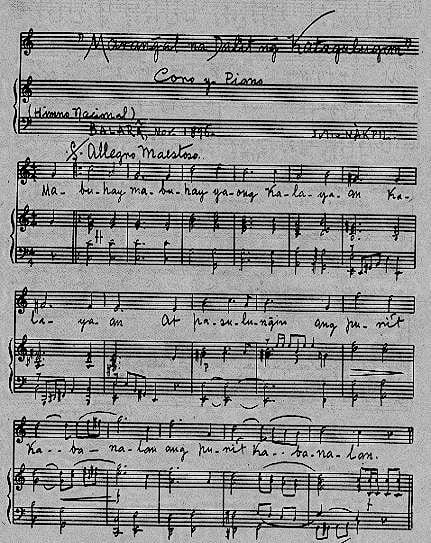The Search for a National Anthem
There was a time when a great number of European monarchies had the hymn “God Save the Queen’ (or King) as their official anthem. The difference was seen only in the languages of these monarchies —So one would have heard versions of it in different lyrics, of different tongues. Even the confederacy of Switzerland, one of the early republican sovereigns in Europe had the music of ‘God Save the Queen” as their anthem until they took hold of reality to change it.
The “Age of Enlightenment” brought in a new mindset in Europe — It is thru this thinking, of reason above belief, logic, and freedom of men above institutions like the church, etc, that revolutions were born. Above all, it highlights distinctions and individuality. It also ushered in nationalism in arts in the 19th century. Folkloric themes became prevalent not only in visual arts but also in music. Thus Zarzuela was celebrated in Spain, the Mazurka was given a classic treatment by Chopin with other composers following suit with their native tunes and folk dances. Etc. National anthems began to emerge from the cocoon of individuality among nations. Each one wanting to highlight its own uniqueness.
Many national anthems were born out of great struggles, highlighting the sacrifice of the sons of the Motherland against an invading power — A call of unity and sacrifice which also transcends borders – It is not a surprise that the lines and music of Rouget de Lisle “La Marseillaise” had influenced great nationalist movements around the world in that distinct time. Perhaps to a stretched extent: The Philippine national anthem which was first known as "Marcha Filipina-Magdalo" is imbued with some of de Lisle's distinct music intervals.
It was no surprise that the Katipunan and its leadership saw the need to come up with a national hymn. The honor was given to a one-time pianist of Malacañang, a true-blooded “harangista” (for the modern Filipino musicians lingo), who perhaps also jotted down notes, observing the many evenings he spent playing waltzes and Biedermeier music to Governor-General Despujol and his guests. A usable intelligence masked in musical soirees?
On February 1897, months after taking a higher position in the northern command of Katipunan based in Pasig, the former Malacañang pianist—Julio Nakpil sent a copy of the commissioned anthem to the Supremo. It would be one great national treasure if the copy still exists somewhere. And who would ever find the original manuscript? Nakpil called it a Dalit, the old and seldom used Tagalog term for “hymn”— The honorable hymn of the Tagalogs or Katagalugan.
On June 12, 1898, what was heard for the first time and continues to be part of our daily grind standing up each morning to give honor to and to sing, was the anthem of Aguinaldo. We sing unmindful of the controversies behind it or the intrigues that haunts the nation, that between Bonifacio and Aguinaldo. Simply saying, the one who emerged victorious in that rivalry went on to provide the anthem.


.jpg)
.png)


Comments
Post a Comment